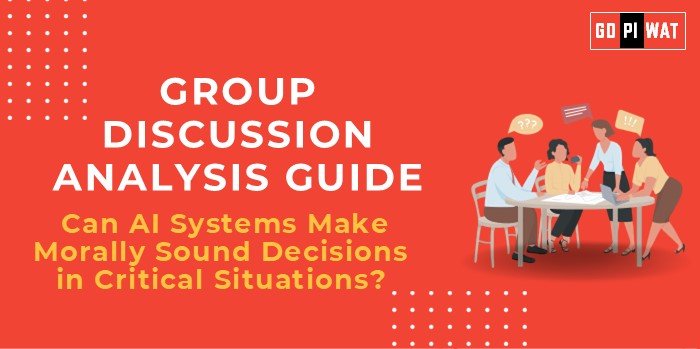📋 Group Discussion (GD) Analysis Guide: Can AI Systems Make Morally Sound Decisions in Critical Situations?
🌐 Introduction to AI and Moral Decision-Making
- 🔍 Opening Context: “As artificial intelligence becomes increasingly integrated into critical decision-making areas like healthcare, law enforcement, and autonomous vehicles, its moral reasoning capabilities are under intense scrutiny.”
- 📖 Topic Background: AI systems are designed to process data and make decisions based on pre-programmed logic and learned patterns. However, the morality of their decisions—especially in life-critical situations—raises complex ethical questions about accountability, fairness, and the nature of morality itself.
📊 Quick Facts and Key Statistics
– 🌍 AI Market Growth: The global AI market is projected to reach $1.81 trillion by 2030 (Statista).
– 🩺 AI in Healthcare: AI-driven diagnostics achieve 85-90% accuracy, matching or surpassing human experts (WHO, 2023).
– ⚠️ Bias Issues: Over 40% of AI systems in criminal justice were flagged for racial bias (ACLU, 2023).
– 🚘 Autonomous Vehicles: Tesla’s self-driving cars faced 35 crash investigations by 2023 (NHTSA).
– 🩺 AI in Healthcare: AI-driven diagnostics achieve 85-90% accuracy, matching or surpassing human experts (WHO, 2023).
– ⚠️ Bias Issues: Over 40% of AI systems in criminal justice were flagged for racial bias (ACLU, 2023).
– 🚘 Autonomous Vehicles: Tesla’s self-driving cars faced 35 crash investigations by 2023 (NHTSA).
🤝 Stakeholders and Their Roles
- 💻 Developers and Companies: Build AI systems and define ethical frameworks.
- ⚖️ Governments and Regulators: Create policies for accountability and fairness.
- 👩⚕️ Users (e.g., doctors, law enforcement): Implement AI tools in real-world scenarios.
- 🧠 Society and Philosophers: Debate the ethical principles underpinning AI decisions.
🏆 Achievements and Challenges
✨ Achievements:
- ⚡ Efficiency in Critical Sectors: AI systems reduce medical diagnostic errors and assist in disaster response planning.
- 🛠️ Bias Mitigation Efforts: Tools like IBM’s AI Fairness 360 aim to identify and reduce biases in decision-making.
- 🌍 Global Collaboration: The EU’s AI Act sets global standards for ethical AI.
⚠️ Challenges:
- 📊 Bias and Discrimination: Algorithms often mirror the biases in their training data.
- 🔒 Transparency Issues: Many AI systems operate as “black boxes,” making their decision processes opaque.
- ⚖️ Moral Dilemmas: AI struggles in situations requiring value judgments, like self-driving cars deciding between two harmful outcomes.
🌎 Global Comparisons: Japan integrates AI robots into elderly care with cultural sensitivity programming, while the U.S. faces increased scrutiny on bias in AI-driven criminal justice systems.
📌 Case Study: The Boeing 737 MAX Crisis highlights how software-driven decision errors underscore the importance of transparency and human oversight in critical systems.
🧠 Structured Arguments for Discussion
- ✅ Supporting Stance: “AI systems, when programmed with ethical frameworks and rigorous checks, can outperform humans in consistency and fairness.”
- ❌ Opposing Stance: “AI cannot fully replicate human morality as it lacks the emotional intelligence and contextual understanding necessary for critical decisions.”
- ⚖️ Balanced Perspective: “AI offers opportunities for enhanced decision-making but must be deployed alongside human oversight to navigate moral complexities.”
🎯 Effective Discussion Approaches
- 📜 Opening Approaches:
- 💡 Start with a real-world scenario, such as a healthcare AI saving lives but raising ethical dilemmas about unequal access.
- ⚖️ Highlight contrasting opinions, like efficiency vs. morality in AI decisions.
- 🔍 Counter-Argument Handling:
- Use examples like biased facial recognition systems to challenge overreliance on AI.
- Advocate for hybrid models combining AI efficiency and human judgment.
🔍 Strategic Analysis of Strengths and Weaknesses
- 💪 Strengths: Consistency, scalability, data-driven insights.
- ⚠️ Weaknesses: Lack of empathy, data bias, ethical limitations.
- 🚀 Opportunities: Ethical AI development, global standards, interdisciplinary research.
- ⚡ Threats: Public mistrust, misuse, and unintended consequences.
🎓 Connecting with B-School Applications
- 🌟 Real-World Applications: Ethical AI frameworks could align with B-school projects in risk management or innovation strategy.
- ❓ Sample Questions:
- “Should AI ethics be a mandatory component in all AI-related projects?”
- “Discuss a scenario where AI failed in moral decision-making and how it could have been prevented.”
- 💡 Insights for Students: The topic links to leadership challenges in technology ethics and strategic decision-making.


